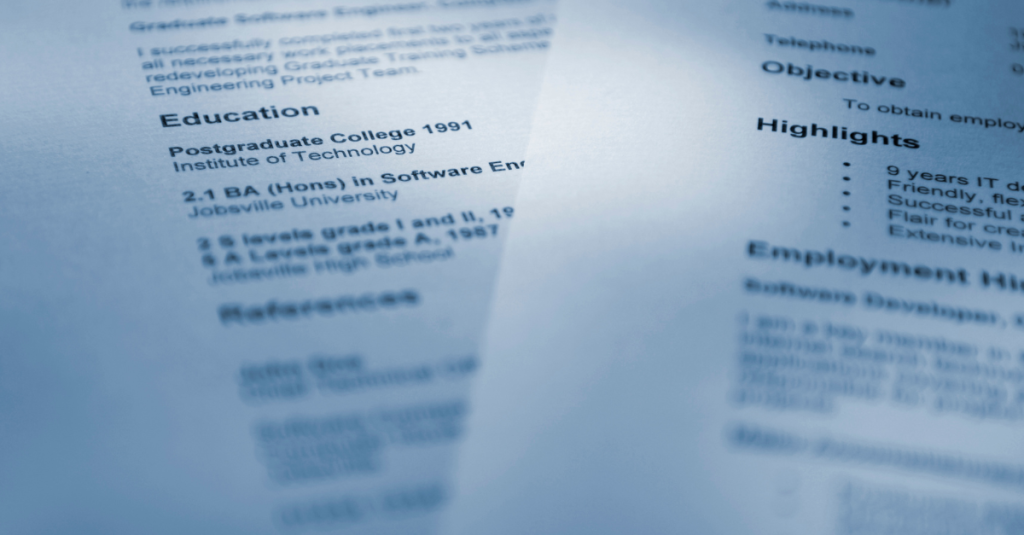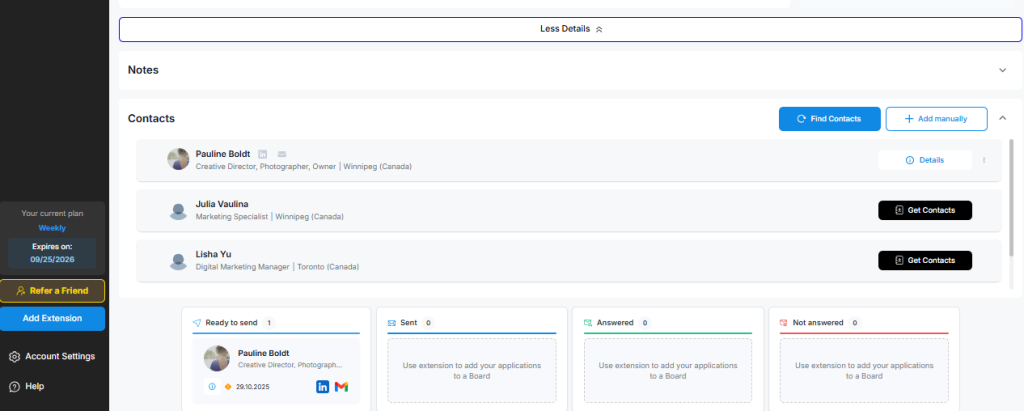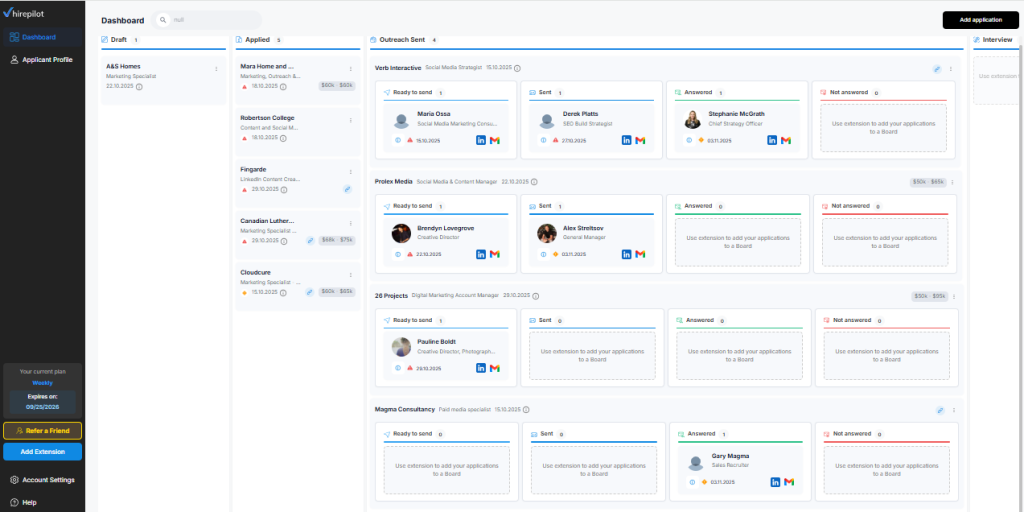Feeling stuck in your job search? Sending out dozens of applications only to hear nothing back is frustrating and can seriously dent your confidence. You know you have the skills and experience, but you’re not getting the chance to prove it. The problem isn’t you; it’s your strategy. To get more interviews, you need a modern, tactical approach that cuts through the noise and puts you directly in front of hiring managers.
This guide will give you a comprehensive, step-by-step framework to transform your job search. We’ll move beyond simply “applying for jobs” and into a strategic system designed to maximize your chances. You will learn how to target the right roles, optimize your resume for both bots and humans, network effectively using AI, and manage your entire process like a pro. It’s time to stop chasing opportunities and start creating them.
Understanding the job market reality
The job market has evolved. The days of submitting a generic resume and hoping for the best are long gone. Today, you’re competing against hundreds of other applicants, and your first hurdle is often an Applicant Tracking System (ATS), a software designed to filter out resumes before they ever reach a human. According to data, 75% of resumes are rejected by an ATS and never seen by a recruiter.
Furthermore, recruiters and hiring managers are overwhelmed. They spend mere seconds glancing at each resume that makes it through the initial filter. To succeed, your job search strategy must be multi-faceted. You need to combine powerful resume optimization with proactive networking and targeted applications. It’s not just about applying; it’s about marketing yourself as the ideal solution to a company’s problem.
This reality isn’t meant to discourage you, it’s meant to empower you. By understanding the challenges, you can build a strategy that directly addresses them, giving you a significant advantage over other candidates.
Define your Ideal Company Profile (ICP): stop spraying and praying
One of the biggest mistakes job seekers make is applying for anything and everything that looks remotely suitable. This “spray and pray” approach leads to burnout and poor results. A more effective method is to define your Ideal Company Profile (ICP), just as a sales team would define its ideal customer.
This means getting crystal clear on the type of company, role, and environment where you will thrive.
How to build your ICP: a checklist
- Industry: What industries are you passionate about or have experience in? (e.g., SaaS, renewable energy, healthcare tech)
- Company size: Do you prefer a small, agile startup, a mid-sized company with growth potential, or a large, established corporation?
- Company stage: Are you drawn to a Series A startup building from scratch or a mature, publicly traded company?
- Culture and values: What work environment suits you best? Look for clues on the company’s “About Us” page, social media, and employee reviews on sites like Glassdoor. Do they value collaboration, autonomy, work-life balance?
- Location & work model: Are you looking for a fully remote, hybrid, or in-office role? If you’re open to relocating, which cities are on your list?
- Role specifics: What are the non-negotiable responsibilities you want in your next role? What skills do you want to use daily?
Once you have this clarity, you can create a target list of 20-30 companies that fit your ICP. This focused approach allows you to tailor your materials and outreach, dramatically increasing your response rate.
Craft your value proposition: what makes you the best hire?
With your target companies identified, you need to articulate why they should hire you. Your value proposition is a concise statement that summarizes the unique value you bring to an employer. It answers the question: “Why are you the perfect fit for this role and this company?”
Think of yourself as a solution. What problems does the company face that you can solve? Review the job descriptions from your target list. Identify the core challenges they need to overcome.
Building your value proposition
- Identify your core strengths: What are your top 3-5 skills? Combine hard skills (e.g., Python, SEO, financial modeling) with soft skills (e.g., leadership, communication, problem-solving).
- Quantify your accomplishments: Don’t just say you “improved efficiency.” Say you “streamlined the reporting process using automated scripts, reducing manual data entry by 15 hours per week.” Numbers are proof of your impact.
- Align with company needs: Connect your accomplishments directly to the role’s requirements. If they need someone to grow their social media presence, highlight your experience in doubling follower counts or increasing engagement by 50%.
Example value proposition (for a Marketing Manager role):
“I am a data-driven marketing manager with over 7 years of experience scaling user acquisition for B2B SaaS companies. At my previous role, I led a team that reduced cost-per-acquisition by 30% while increasing qualified leads by 200% in 12 months by optimizing paid channels and launching a new content strategy.”
Master your resume: ATS resume optimization and keyword strategy

Your resume has two audiences: the ATS and the human recruiter. You must optimize for both to get more interviews.
Beating the bots: ATS resume optimization
An ATS scans your resume for keywords and phrases that match the job description. If your resume lacks these keywords, it gets filtered out.
Step-by-step ATS optimization:
- Analyze the job description: Copy the text from the job description and paste it into a word cloud generator. The largest words are your primary keywords.
- Integrate keywords naturally: Sprinkle these keywords throughout your resume, especially in your “Skills” section and in the descriptions of your work experience. Use the exact phrasing from the job description (e.g., “project management” vs. “managed projects”).
- Use a simple format: ATSs struggle with complex formatting. Stick to a clean, single-column layout. Avoid tables, text boxes, and images. Use standard fonts like Arial, Calibri, or Times New Roman.
- Standard section headers: Use conventional headers like “Work Experience,” “Education,” and “Skills.” The ATS is programmed to look for these.
- Submit the right file type: Unless specified otherwise, submit your resume as a .docx or .pdf file.
For a deeper dive into optimizing your resume, our guide on ATS Keywords in 2025 provides detailed examples and strategies to ensure your application gets past the bots.
Winning over the human: readability and impact
Once your resume passes the ATS, a human will read it. They need to see your value proposition in seconds.
- Use a professional summary: Start with a 3-4 line summary that encapsulates your value proposition.
- Focus on achievements: Use bullet points with the “Challenge-Action-Result” formula. Start each point with a strong action verb.
- Keep it concise: Aim for a one-page resume if you have less than 10 years of experience. Two pages are acceptable for more senior professionals.
Show, don’t just tell: the power of portfolios and work samples
A resume tells people what you’ve done. A portfolio shows them. For many roles—in marketing, design, software development, writing, and even sales—a portfolio or collection of work samples is essential. It provides tangible proof of your skills and gives you a massive competitive edge.
What to include in your portfolio:
- Case studies: Detail a project from start to finish. Explain the problem, your process, the challenges you faced, and the results you achieved.
- Project highlights: Showcase your best work. This could be a marketing campaign, a piece of code, a design mockup, or a writing sample.
- Testimonials: Include quotes from previous managers, clients, or colleagues that speak to your skills and work ethic.
Don’t have a formal portfolio? You can create a simple one-page document with links to your work or a personal website. Link to it in your resume header and email signature.
AI-powered outreach: networking for jobs in the digital age

Networking remains the most powerful job search tool. A study by LinkedIn found that 85% of all jobs are filled via networking. However, traditional networking has been supercharged with AI. Instead of blindly connecting on LinkedIn, you can use technology to find the right people and craft personalized messages that get replies. Networking for jobs is now smarter and more efficient.
How to use AI for outreach
- Identify key contacts: For each of your target companies, identify the hiring manager for your desired role, a potential future peer, and a recruiter. Tools like LinkedIn Sales Navigator and specialized AI platforms can help you find these contacts quickly.
- Draft personalized messages: AI can help you draft compelling outreach messages. Platforms like HirePilot analyze a person’s LinkedIn profile and recent activity to suggest personalized hooks. This moves you beyond a generic “I’d like to connect” message.
- Automate your follow-up: Staying top-of-mind is crucial. Use tools to schedule follow-up messages so no connection falls through the cracks.
A strategic outreach message focuses on building a relationship, not just asking for a job. For an in-depth guide on this, explore our article on AI Outreach Strategies (2025–2026). You can also learn how to reach hiring managers directly with AI and bypass the crowded application portals.
Apply strategically: why quality beats quantity
Once you’ve optimized your resume and started your outreach, it’s time to apply. But remember, the goal isn’t to submit the most applications. The goal is to get the most interviews. Focus your energy on the 20-30 companies on your ICP list.
For each application, spend 20-30 minutes tailoring your resume and writing a short, impactful cover letter. Reference your value proposition and connect it directly to the needs outlined in the job description. A single, highly-targeted application is worth more than 50 generic ones. According to Indeed Career Guide’s Strategic Job Search Plan, organizing your time and tailoring each application dramatically improves response rates. As noted, recruiters value candidates who show genuine interest and have taken the time to customize their application.
Prepare to win: interviewing frameworks for success
Your hard work has paid off, and the interviews are starting to roll in. Now is the time to prepare. Solid preparation is one of the most crucial interview tips for success. Don’t just “wing it.”
The STAR method
The STAR method (Situation, Task, Action, Result) is a proven framework for answering behavioral interview questions (“Tell me about a time when…”).
- Situation: Briefly describe the context.
- Task: Explain your specific responsibility or goal.
- Action: Detail the steps you took to address the situation. This is where you highlight your skills.
- Result: Quantify the outcome. What was the impact of your actions?
Practice answering common questions using this framework. For a comprehensive list, check out our guide to the Top 30 Job Interview Questions and Answers.
Prepare your questions
An interview is a two-way street. Prepare 5-7 insightful questions to ask the interviewer. This shows your engagement and helps you determine if the company is a good fit for you. Good questions focus on the team, the challenges of the role, and the company’s future. For more on this, our guide on how to prepare for a job interview covers this in detail.
The art of the follow-up: systems to stay top-of-mind
Your work isn’t done when the interview ends. A prompt and professional follow-up can set you apart from other candidates. Research from the Society for Human Resource Management (SHRM) confirms that a thank-you note is still expected and appreciated by most hiring managers.
The follow-up system
- Immediate thank-you Email: Send a personalized thank-you email to each person you interviewed with within 24 hours. Reference a specific point from your conversation to jog their memory and reiterate your interest in the role.
- Follow-up cadence: If you don’t hear back by the timeline they provided, it’s appropriate to send a polite follow-up. A simple check-in can keep your application from getting lost in the shuffle.
We provide effective templates and strategies in our guide on how to follow up on a job application.
Your weekly operating rhythm: a structured plan for results
A successful job search requires consistent effort. Treat it like a project, with dedicated time blocks and weekly goals. This structure prevents burnout and ensures you are always making progress.
Sample weekly schedule
- Monday (strategy & targeting):
- Find 5-10 new roles at companies on your ICP list.
- Identify key contacts (hiring managers, recruiters) for each role.
- Tuesday (outreach & networking):
- Send 10-15 personalized connection requests or outreach messages.
- Follow up on previous outreach.
- Wednesday (application day):
- Submit 3-5 highly tailored applications.
- Customize your resume for each one.
- Thursday (interview prep & skill building):
- Practice answering interview questions.
- Work on a portfolio piece or take an online course.
- Friday (follow-up & review):
- Send follow-up emails for applications and interviews.
- Update your job search tracker and review your weekly metrics.
As noted in York College CUNY’s Job Search Strategies Guide, successful candidates combine targeted applications with consistent networking and resume optimization.
Track your progress: metrics and dashboards for a smarter search

You can’t improve what you don’t measure. A job application tracker is your best friend. It helps you stay organized, manage follow-ups, and understand what’s working.
Key metrics to track:
- Applications sent: The number of tailored applications you submit each week.
- Outreach messages sent: Your networking volume.
- Response rate: The percentage of outreach messages that get a reply.
- Screening calls: The number of initial interviews you secure.
- Interviews: The number of full interviews you land.
Analyzing these numbers helps you diagnose problems. A low response rate might mean your outreach messages need work. Plenty of screening calls but no second interviews could signal a need for better interview preparation. An expert at Indeed suggests that tracking your progress can help you refine your strategy over time, making your search more efficient.
Tools like HirePilot offer a built-in job application tracker to automate this process, so you can focus on high-value activities.
Common pitfalls to avoid in your job search
Even with a great strategy, it’s easy to fall into common traps. Be mindful of these pitfalls:
- The “Black Hole” mentality: Don’t just rely on online applications. Always combine applications with direct outreach.
- Generic materials: Never use a one-size-fits-all resume or cover letter. Customization is key.
- Passive networking: Simply connecting on LinkedIn is not enough. You must engage with people and build real relationships.
- Ignoring follow-ups: Failing to follow up is a missed opportunity to stay top-of-mind.
- Losing momentum: A job search is a marathon, not a sprint. A structured weekly rhythm helps maintain momentum.
As highlighted in Harvard Business Review, a proactive and strategic mindset is what separates successful job seekers from the rest.
Your action plan to get more interviews
You now have a complete playbook to transform your job search and get more interviews. Stop the frustrating cycle of applying with no response. It’s time to take control with a tactical, data-informed strategy. By defining your targets, crafting a compelling value proposition, optimizing your materials, and networking with intention, you’ll open doors you never thought possible.
Feeling overwhelmed by all the steps? That’s where technology can help. HirePilot was built to automate the tedious parts of this process from tracking applications to finding contacts and drafting outreach messages. It empowers you to focus on what matters most: connecting with people and acing your interviews.
Ready to implement this strategy and land your dream job faster?
Take control of your job search with HirePilot today!
What to do next this week:
- Action 1: Draft your Ideal Company Profile (ICP) and create a target list of 20 companies.
- Action 2: Refine your core value proposition and update your resume with quantified achievements.
- Action 3: Run your resume and one target job description through a word cloud tool to identify keywords for ATS resume optimization.
- Action 4: Identify 5 hiring managers or recruiters at your target companies and draft personalized outreach messages.
FAQ: How to get more interviews
- How can I get more interviews with no experience?
To get more interviews with limited experience, focus on your transferable skills, academic projects, and volunteer work. Create a “projects” section on your resume to showcase relevant work, build a small portfolio, and write a compelling summary that highlights your passion and potential. Proactive networking is also crucial; connect with people in your target industry and ask for informational interviews. - How do I know if my resume is the problem if I’m not getting interviews?
If you’ve sent over 50 tailored applications and have not received any calls, your resume is likely the issue. It’s probably not optimized for Applicant Tracking Systems (ATS). Use online tools to check your resume’s ATS compatibility and ensure it’s filled with keywords from the job description. This is the first step to get more interviews. - Is it better to apply to 100 jobs or focus on a few?
Quality over quantity is the best strategy to get more interviews. Sending out 100 generic applications often leads to a 0% response rate. Instead, focus on 5-10 highly targeted applications per week where you’ve tailored your resume, written a custom cover letter, and attempted to network with someone at the company. - How can networking help me get more interviews?
Networking helps you bypass the formal application “black hole.” A referral from an internal employee dramatically increases your chances of landing an interview. Networking also provides insider information about the role and company culture, helping you tailor your application and prepare more effectively. - What is the fastest way to start getting more interviews?
The fastest way is a combined approach: 1) tightly define your target roles, 2) heavily optimize your resume with keywords for those roles, and 3) send personalized outreach messages to the hiring managers or recruiters for those exact roles. This direct, three-pronged attack is far more effective than just applying online. - I’m getting first interviews but no second ones. What should I do?
If you’re consistently failing to advance past the initial screening, the issue lies in your interviewing skills. Practice the STAR method to structure your answers, prepare insightful questions for the interviewer, and be ready to clearly articulate your value proposition. Improving your storytelling and confidence in the interview itself is key.
